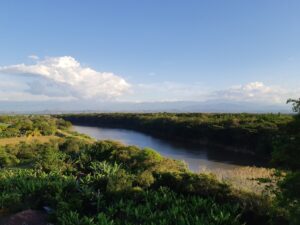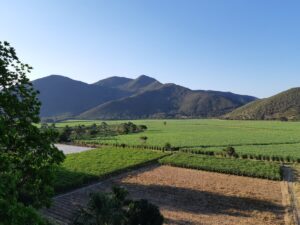The first memories I have about the bicycle come from a long time ago, and I could say that when I was approximately four years old, I already wanted to be on a bike, like most of the people I saw on the streets of the town.
I grew up in a town of 14,000 inhabitants in Colombia, which means that it is a community with a small population compared to the big cities in the world. It is a small place, which means that the social conditions are different in their practicality and perhaps slower. Cars are not used much in the towns; people usually get around on foot, by bicycle, or by motorcycle. Everything is relatively close, and the roads or mountains facilitate the use of these means of transport.
I have very explicit scenes from my memories with the bikes—all kinds of images. A man was transporting fruits and vegetables on his bicycle. A lady was taking her children to school by bicycle. Other people are on their way to work on bikes. I remember my teachers arriving at the school garden on their bicycles, which had baskets that carried their folders and books. I remember that, in the afternoons, it was very common to go to the park and see the boys and girls on their bicycles, playing all kinds of games, from races to a bit of practice with acrobatics. I remember asking for my first bike when I was four years old as a Christmas present. Surely I had good behavior because it was at that age that my relationship with this means of transport that is so important worldwide began.
Curiosity drives us to inquire about things that interest us, and ever since I got my first bike, I have wanted to find out about all the possible ways to use it and learn how to do it properly. The first step, of course, is to learn to ride a bike without the support of four wheels. The goal in childhood is to learn to ride a bicycle on two wheels.
Time went by, and I realized that there are different practices to do and learn by bicycle. Among these practices, we find BMX, which is a sport that has two disciplines; one is the races that aim to complete a route in the shortest time possible, and the other is acrobatics, which is about making movements with the body and with the bicycle, which generate positive points. The bike has a unique design and tires for these terrains, typically practiced since childhood.
I realized that in the town, the youngest ones met to create tracks to compete in BMX, and they did it themselves with shovels, removing and organizing the earth to build ramps. Usually, a person who knew about the subject taught them techniques and trained them in this sport.
There is another sports practice, and it is the Trial. In this discipline, the objective is to reach the finish line without speed, only with balance, starting from the ground to the top of an obstacle. The obstacle can be a barrel, rocks, vehicles, or others. It is a more professional and adult practice, and the design of the bicycle is also specifically for this discipline since they usually do not have a saddle or gears.
I discovered the Bike Trial on television, and throughout my childhood, I heard people talking about it. It is a sport that they describe as high intensity and risky. It would be best if you had a lot of practice to do it well and even participate in competitions.
Among the disciplines applied to cycling, I also discovered mountain biking. It is the one that has caused me the most curious of all the ways of using a bicycle because it has seemed to me, as I have grown, that practicing mountain biking is a personal delight. In this modality, you ride a bike outdoors and in natural environments. In general, and doing it professionally, circuits of 6km in length and categories and tests that can last a minimum of 45 minutes and up to 3 hours of travel are made.
With mountain biking, there is a massive advantage in my country, and that is that Colombia is crossed by mountain ranges that allow cyclists to have incomparable landscapes in front of their eyes. That is an advantage of riding on two wheels in Colombia. The mountainous terrain becomes a gift and a passion for those who decide to practice these disciplines because there are also good rural roads, and that is where I realize that route biking exists.
When I realized that road cycling exists, I began to learn about cycling history in Colombia. This discipline is practiced on asphalt, and when discussing competitions, different tests appear, in which the objective is always to finish each stage in the shortest possible time.
My curiosity about road cycling was awakened in me when I was in my teens. It opened the doors for me to meet excellent references for Colombian cycling. I realized then that my country is a cradle of outstanding talents in cycling and that we have very valuable representatives in this sport worldwide.
Boyacá, a city of Colombia, is located in the Andes mountain range, a department of Colombia where great representatives of international cycling originate: Nairo Quintana, Egan Bernal, and Rigoberto Uran. They have been outstanding athletes, and thanks to them, cycling is news every day in our country.
Thanks to them and other references, we have also been represented internationally, such as in the New York Times; in 2019, an article entitled “The Colombian Who Made History at the Tour de France” was published by Sinar Alvarado and made known worldwide that: “Bernal, 22, is not only the first Colombian to win but also the youngest champion of the Tour de France since 1909, and the first Latin American champion in the entire history of the competition. With his win, he fulfilled what had been a Colombian dream since 1975, when Cochise Rodríguez, an early luminary for that country in the sport, made his debut in the race and finished 27th overall.”
Clearly, for Colombians, cycling has been idealized as a sport that generates pride and has become a passion for all fans who practice it. Cycling is part of Colombian DNA. We realize that we have high-level cycling and that the people who have managed to stand out have worked hard and trained hard to achieve it, which has also been shown at an international level.
There are press headlines, videos, images, and articles that tell us that the Colombian is characterized by his “berraquera”, which translates to strength and courage not to give up even though there are many obstacles. As the New York Times proves again in the article “Tour de France Lead Changes Hands as Hail Shortens Stage,” also published in 2019 by Victor Mather, in which he comments on the great triumph of our fellow athlete. “The twist allowed the Colombian Egan Bernal to take the overall lead from the Frenchman Julian Alaphilippe on a day when Thibaut Pinot, also of France, dropped out.”
REFERENCES:
The Colombian Who Made History at the Tour de France – Sinar Alvarado
Tour de France Lead Changes Hands as Hail Shortens Stage – Victor Mather
https://www.nytimes.com/2019/07/26/sports/cycling/tour-de-france-yellow-jersey-pinot-bernal.html?searchResultPosition=3
Pictures: By me when I use to practice Mountain Bike.






Dear Ivan,
I think the purpose of your article was to discuss your journey of learning cycling, not just how to do it but also about it. This article addresses a wide range of people and perhaps people who are into sport, health, and lifestyle. I like that you start strong with your memories and smoothly transition and build up points. For example, “the first memories I have about the bicycle come from a long time ago, and I could say that when I was approximately four years old, I already wanted to be on a bike, like most of the people I saw on the streets of the town”. I also appreciate the pictures you included (you might be a photographer). For suggestions, I think you close on a stronger statement. Otherwise, this was very well written.
Sincerely,
Salomee Khawja
Edit: *I think you should close on a stronger statement.
Dear Ivan,
I liked the idea of your article, it’s very unique. I really liked how personal the article was. I also liked the use of details and description throughout your article. I would recommend adding a title and starting your article with a more generalized paragraph before talking about your personal experience. I liked the phrase you used to start your 3rd paragraph, “Curiosity drives us to inquire about things that interest us” it drives your audience nicely to your point of the paragraph. I found myself learning new things while reading your article.
Rouba Ali Al Saeedi